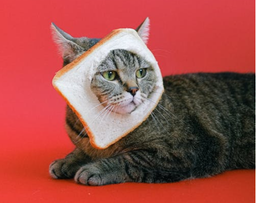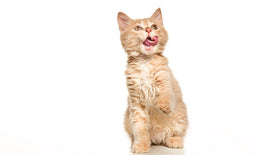Treat or trouble—can cats eat chocolate?
Did you treat yourself to a piece of chocolate only to discover that your furry friend got a hold of the rest of the bar? As quick as you are to react, your cat probably ate some, and now you’re stuck asking yourself, “can cats eat chocolate?”
Untamed breaks down whether chocolate can be a part of your feline companion’s nutrition and what impact it might have on their sensitive organism. If you’re unsure what cats can’t eat, this guide will show you which ingredients in cat food to look out for and what alternative treat options you can go for!

Is it OK for cats to eat chocolate? Hopefully, yours is more interested in the box than the cacao goodies!
Source: Freepik
Should cats eat chocolate?
Chocolate is a delicious dessert and typical comfort food for humans, but should you share it with your cat while you’re binge-watching your favorite show?
The answer is no! You should never give chocolate to cats because it can cause poisoning and can be harmful to both kittens and adult felines.
What makes chocolate harmful to cats?
The cacao plant—which is used in making cocoa powder and chocolate—contains two substances that are addictive to humans but cause potentially fatal poisoning in cats:
- Theobromine
- Caffeine
Darker chocolate has higher caffeine and theobromine concentration because it contains more cocoa, which makes baking chocolate most dangerous to cats. That being said, you should avoid giving your cat any kind of chocolate and do your best to keep it out of their reach.
Does that mean white chocolate isn’t toxic to cats?
White chocolate does not contain cocoa, but it typically has excessive amounts of sugar and artificial flavouring, both of which are unnecessary for your feline friend.
Sugar can cause various problems to your cat, including:
- Excessive weight gain
- Dental issues
- Diabetes
Artificial flavouring isn't a harmful ingredient, but it can signify that other ingredients in that particular food are. Quality food is palatable and tasty as is and doesn’t need artificial flavouring.
What happens if a cat eats chocolate?
Is your kitty acting strange, and do you remember leaving chocolate on your counter or table? Your cat might have laid their paws on it.
If you want to know whether your cat consumed some chocolate, look out for the following signs:
|
Early signs |
Late signs |
|
The symptoms manifest within 6–12 hours after ingesting chocolate. In severe cases, chocolate consumption can even cause seizures or coma in cats.
Can a cat die from eating chocolate?
If a cat consumes a large amount of chocolate and doesn’t get proper treatment, the toxins (theobromine and caffeine) can cause death.
What to do if your cat eats chocolate
If your furry friend shows any symptoms mentioned above or you see them consume chocolate, you should do one of the following:
- Call or bring your cat to the veterinarian
- Call the Animal PoisonLine
Call or bring your cat to the veterinarian
You can call your vet and explain that your cat consumed chocolate, and they will advise whether you should bring your feline in.
If you end up visiting the vet’s office, try to keep your cool as your cat will sense if you’re panicking and reflect those emotions, making it harder for the vet to inspect them and administer proper treatment.
Your vet will perform a physical exam and lab tests to determine the severity of the poisoning and discover any other potential abnormalities. Some of the tests they might do are:
- ECG
- Urinalysis
- Electrolyte panel
- Chemical blood profile
After determining the state of your cat, the veterinarian will:
- Induce vomiting or administer activated charcoal—It will help get rid of the harmful ingredients present in chocolate and prevent further toxemia
- Administer intravenous fluids—This will rehydrate your cat, dilute the toxic ingredients, and speed up metabolic processes to get rid of the chocolate as soon as possible
- Provide additional medication—If your feline friend is experiencing tremors or arrhythmias because of the poisoning, the vet will provide adequate medication to ease those symptoms
If the vet’s office policy or current COVID-19 restrictions allow it, try not to leave your friend’s side since they will probably be significantly stressed out by the rush and the vet’s office.
Call the Animal PoisonLine
Suppose your veterinarian is unavailable, and there are no others in the area that could help you. In that case, you should contact the Animal PoisonLine by calling 01202 509 000. The Animal PoisonLine is the only 24-hour hotline in the UK assisting cat parents in taking the proper steps to treat their potentially poisoned pets.
Each call you make costs:
- £35 if you’re calling from Monday to Friday, between 8 a.m. and 8 p.m.
- £45 if you’re calling at any other time
Once you provide details about what happened, the specialist will inform you whether you should visit the veterinarian immediately or treat your feline friend yourself. If the poisoning isn’t severe and you can treat them yourself, the specialist will inform you about the medication you can use and the best way to administer it.

Don’t wait for your cat’s symptoms to worsen to call for help.
Source: guvo59
How much chocolate can a cat eat?
You should never let your furry friend eat chocolate. That being said, if your cat lays paws on the dessert, they will experience discomfort, but it might not necessarily poison them.
The amount of chocolate your cat might be able to process without poisoning depends on:
- The type of chocolate
- Your companion’s weight
Take a look at the amounts of different kinds of chocolate an eight-pound cat can consume before being at risk of poisoning:
|
Type of chocolate |
Toxic amount |
Equal to |
|
Milk chocolate |
Around 32 grams |
A third of a regular 100 g chocolate bar |
|
Semisweet chocolate |
Around 14 grams |
One row of a regular 100 g chocolate bar |
|
Dark chocolate |
Around 14 grams |
One row of a regular 100 g chocolate bar |
|
Baking chocolate |
Around 5 grams |
Less than one piece of a regular 100 g chocolate bar |
As you can see, your cat can be in danger even if they take a tiny bite of baking chocolate.
How to keep chocolate out of paw’s reach
There are ways you can enjoy your favourite chocolate bars and desserts while keeping them out of your little adventurer’s reach. Try some of the following methods:
- Use air-tight containers—Cabinets and drawers might pose no challenge to your cat, but they won’t find a way to open air-tight containers
- Store your chocolate in a drawer with a lock—Unlocking your drawer every time you want to treat yourself to some chocolate may seem like too much work, but it could save your furry friend’s life
- Buy and eat chocolate when you crave it, instead of storing it in your home—Your kitty can’t eat chocolate if there is none
- Keep your feline friend in a separate room while baking—If you have a sweet tooth and like to bake, you can let your furry friend play in another room until you’re done. Remember to store those cookies somewhere safe!
Other foods that can cause serious health problems in cats
Chocolate isn’t the only food that can cause serious health problems for your feline. While many cat parents have the best intentions when feeding human foods to their beloved companions, they risk their health because a feline organism is not made to process those foods properly. Check out the table below to learn about other foods that could potentially endanger your cat’s health:
|
Food |
Health problems it causes |
|
Alcohol |
Vomiting, diarrhoea, choking, coma, and death |
|
Raw bread dough containing yeast |
Stomach bloating and twisting |
|
Citrus fruits |
Upset stomach, vomiting, and diarrhoea |
|
Coffee |
Same as chocolate (due to caffeine and even theobromine in green coffee beans) |
|
Coconut flesh and water |
Digestive problems |
|
Grapes and raisins |
Potential kidney failure |
|
Digestive problems |
|
|
Salt (in large amounts) |
Tremors, seizures, vomiting, diarrhoea, and death |
|
Onions, garlic, leeks, chives, scallions, and shallots |
Gastrointestinal issues and damage to red blood cells |
|
Xylitol (sweetener in sugar-free foods) |
Lethargy, vomiting, and liver failure |
|
Nuts |
Digestive problems and pancreatitis |
|
Fat trimmings |
Vomiting, diarrhoea, and pancreatitis |
|
Small, raw bones |
Damage to the oesophagus and stomach |
|
Seeds and skin of cherries, plums, apples, and pears |
Respiratory issues and shock |
|
Mushrooms |
Drooling, vomiting, diarrhoea, tearing, and liver damage |
Alternative treats for cats that are nutritious and paw-licking good!
If your cat is determined to get treats, you can try offering other options, but remember that cats are carnivores, and treats cannot replace meat and fish. If you want to treat your kitty to something nutritious and delicious, you can try the following options:
- Fruits
- Protein snacks
- Catnip
Fruits you should let your cat try right meow!
Before your kitty starts munching on fruit, keep in mind that:
- Diabetic cats should never eat fruit
- Treats should only be 2% of your cat’s diet
- You need to:
- Cut the fruit into small pieces to prevent potential choking
- Peel the fruits and remove the skin, rind, seeds, stems, etc.
Not sure whether your kitty is berry fond of fruits? Try offering these sweet snacks to your cat:
|
Fruits that are safe for cats to eat |
Fruits that are safe for felines in tiny servings |
|
|
After serving fruit to your furry companion, you need to check whether they are showing symptoms of not being able to digest it comfortably, which are:
- Vomiting
- Diarrhoea
- Constipation
Even though fruit can be a fun snack, please keep in mind that the nutrients in fruit are not bioavailable to cats, so there’s no point in giving strawberries, bananas, or kiwi to your feline. The same goes for vegetables or vegetable derivatives, which can do more harm than good.

What’s with the melon, ma? Are we out of meat?
Source: Piotr Musioł
Protein snacks for healthy cats
Protein is the basis of every happy cat’s nutrition. If you want to treat your kitten to some extra protein, you can choose between:
- Chicken (whole meat as well as the liver and heart)
- Lean beef
- Sardines
- Shrimps and prawns
- Lean deli meats, such as ham
- Salmon
- Mackerel
- Cooked eggs
- Tuna
- Lamb
You should cook all of the meats and fish listed above before serving it to your kitty. While feeding your feline with raw chicken seems like a good idea, and cats did eat raw meat in the past, the situation is a little different now. Domesticated cats shouldn’t be fed a raw diet unless the vet says so.
If you’re looking for protein-packed meals to keep your cat’s coat shiny and energy on a high level, try Untamed! Our meals provide two times more protein than the industry standard and are cooked with human-grade ingredients and love.

Our furry friends love Untamed cat food!
Image (c) Untamed

Once I get this off my face, you’re toast, hooman.
Source: Anna Shvets
Why you should let your feline nibble on catnip
Sniffing catnip can put your feline friend in frenzy mode, but if eaten in moderation, catnip can help your cat relax. Don’t go overboard with fresh or dried catnip leaves, though, because:
- Your cat will have digestive problems
- Your cat will reach cloud nine (Mother Nature has her ways to make life fun, so prepare a camera)

Five more minutes, mom!
Source: Aleksandar Cvetanovic
Cat food ingredients you didn’t know could harm your furry friend
Did you know that for cat food to be labelled as “with chicken,” it only needs to contain 4% of chicken meat? What are the other contents of a cat food portion, then? The answer is:
- Meat derivatives
- Vegetable derivatives (which can even include charcoal!)
- Sugars (glucose and dextrose)
- Cereals
- Additives (up to 4,000 chemicals that are banned for human consumption!)
- Colouring
- Gluten
- Soy
- Rice
All of these ingredients can endanger the well-being of your cat.
Cat food shopping—ingredient checklist
Next time you go shopping for cat food, do your kitty a favour by checking the ingredients. The happiest cats are those whose parents look out for:
|
Ingredient |
Description |
|
Protein |
Protein is essential for your cat’s well-being. At least 25% of the cat food portion must be animal-based protein, but you should always strive for more than 50% |
|
Omega 3 and 6 fatty acids |
Fatty acids are responsible for your cat’s smooth skin and shiny coat. Other benefits of fatty acids are their anti-inflammatory and hypoallergenic properties, which protect allergy-prone cats from allergens, such as:
|
|
Vitamins |
Ideally, cat food should contain the following vitamins:
|
|
Minerals |
Look out for the following minerals when shopping for cat food:
|
What makes cats love Untamed cat food so much?
Do you know that feeling when you come home after a long day, and a cooked meal is waiting for you? Why not provide the same experience for your kitty? With Untamed, you’re ensuring that your feline’s meals are specially prepared for their health and satisfaction. Whether they’re more fond of jelly or gravy formulas, Untamed provides meals every cat goes wild for, even the picky ones!
Some of the reasons our pack members choose us include:
- Human-grade ingredients
- Pre-measured meals that don’t require unfreezing or additional preparation
- Zero additives, artificial colouring, and flavouring
- Plenty of options to choose from
- Recyclable packaging
Know what your cats eat!
We believe that transparency is the best policy! The labels on our tins provide information about the contents of each meal, so you can be sure no grain fillers, meat and vegetable derivatives, or chemicals make their way to your cat’s precious tummy!
Not sure whether you want to make that switch?
We get it—it’s not easy to commit, but you can let your feline friend decide for themselves with our trial option! Take our short quiz to ensure we send you the right type and amount of food to keep your kitty happy and full.
We offer one of the most convenient platforms to buy cat food online—here's how it works:
- Visit our Try Now page
- Tell us more about your kitty
- Select a meal plan and place your order
You’ll get the taster pack in no time, so your cat can sample our tailor-made dishes and choose the one they like. We’ll replenish your stock around the same time every month. If you want to make any changes to your standard order, you can do it any time.
Keep in mind that:
- You don’t have to pay any shipping fees, ever
- You aren’t obliged to commit—you can skip, pause, or cancel your cat food subscription anytime
- The food doesn’t require defrosting or additional preparation—open the tin, and you’re ready to go!

With Untamed cat food, eating time becomes bonding time!
Image (c) Untamed
Cats and cat parents never look back after trying Untamed cat food
The benefits of our meticulously crafted recipes will start to become visible as soon as day one.
Look out for:
- A lot less messy litter box
- Your cat not struggling to do the doo-doo
After two months, your cat will have much more energy because of the high protein concentration in our meals.
Whether your cat’s colour scheme is of a calico, tabby, or tortie, their coat will show its true shine after four months.
Last but definitely not least, with our perfectly portioned meals, you will never have to worry about your cat’s weight again. Try them now—order your first box and see your furry friend thrive!
Check out our other guides to what cats can or cannot eat:
|
|

![Best food for Ragdoll cats in the UK [Broken Down]](http://untamed.com/cdn/shop/articles/featured_best_food_for_ragdoll_cats_uk.jpg?v=1646818249&width=256)

